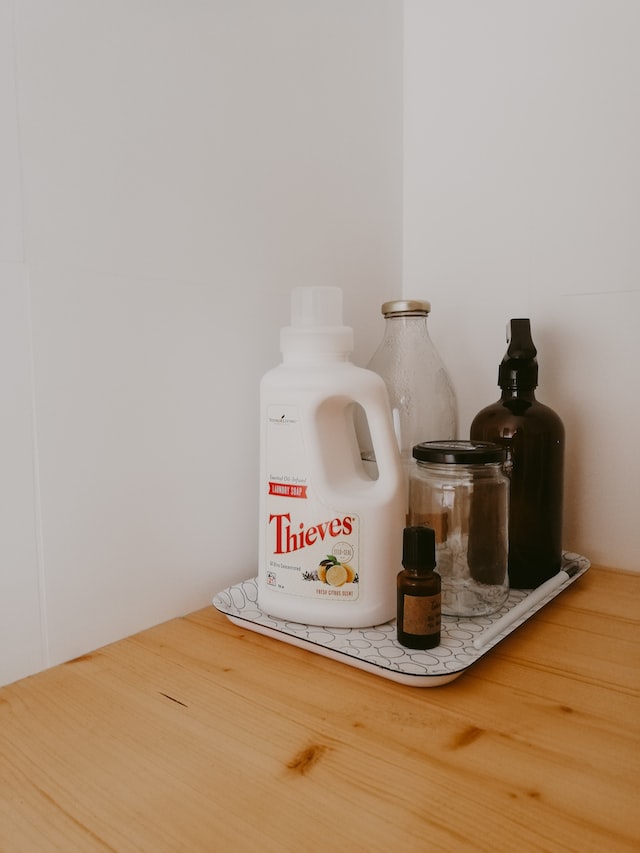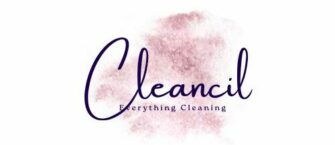Hydrogen peroxide and laundry detergent are two cleaning products with different formulations.
Yet they combine together seamlessly to create a magic cleaning solution that combats difficult to remove stains, brightens laundry, and also disinfects it.
If you’ve been having trouble making your laundry detergent work, then the secret weapon you probably need is hydrogen peroxide.
In this article, you’ll learn more on how to properly combine hydrogen peroxide and laundry detergent to benefit your laundry.

What is hydrogen peroxide?
Hydrogen peroxide is a strong oxidizer with the chemical formula H2O2 which makes it act like a bleach by breaking down the chemical chains of stains (just the way chlorine bleach does).
Hydrogen peroxide however, is a more gentle type of bleach in comparison to the chlorine bleach which makes it suitable for use even on colored clothes — although, still a bleach, and should not be used on delicate fabrics such as silk, wool and cashmere.
Hydrogen peroxide is commonly used in laundry to whiten and brighten clothes as well as to kill bacteria and fungus growth because of its superb disinfecting properties.
Not only can it be used to disinfect clothes, it can also be used to clean washers by adding 2 cups of it (at 3% strength) to the empty washer and running a hot cycle.
When using peroxide, no matter the strength, it is recommended to avoid getting it in contact with your skin or eyes which can cause harm to it.
Always make sure to use gloves and eye protection regardless of the concentration of peroxide you’re working with.
Can hydrogen peroxide and laundry detergent combine?
Yes, you can mix hydrogen peroxide and laundry detergent together in the laundry. The two when combined, create a magic cleaning solution that can help remove tough stains, disinfect laundry and also brighten and whiten white clothes.
How you add hydrogen peroxide to laundry is simple: mix equal parts water and peroxide then add between ¼ to 1 cup depending on how soiled the cloth is. You can choose to soak first, or launder directly. Either way works.
Before using peroxide on clothes however, always make sure you read the fabric care label on the cloth to make sure it’s compatible with oxygen bleach.
Also make sure to test the solution in an inconspicuous area to ensure it isn’t going to discolor after coming out from a hydrogen peroxide bath.
What are the benefits of peroxide in laundry?
Hydrogen peroxide has a lot of benefits when used as a laundry additive. Some of them include:
Stain remover:
One of the ways to use hydrogen peroxide in laundry is as a stain remover. Due to the nature of hydrogen peroxide, it acts as a mild bleach which is safe to use on most fabrics including colored ones — although it is still recommended to do a little patch test whenever you’re using hydrogen peroxide to treat stains, so as to make sure no discoloration occurs after drying.
Hydrogen peroxide will tackle almost every kind of stains that can happen on a fabric such as aged stains, grass stains, grease, oil, blood, wine, and some dye based stains such as ink or marker stains. And it does this by disrupting or breaking down the bonds of the molecules that make up the stain.
To use hydrogen peroxide for stain removal, first dilute it with water to form a 1% solution or slightly more, as you’re mostly going to start with a 3% concentration which is what is normally available to home users and can be pretty harsh when added directly to clothes.
Combine 3 parts water to one part peroxide to form the 1% solution that is very mild when applied to clothing, yet would still offer stain removal properties.
Next, apply the solution using a cotton swab directly on the stain (or to avoid skin contact, use a spray bottle) and use a soft brush to work it in, allow it to sit for some minutes then rinse the area thoroughly under running water and dry the cloth.
Whitener and brightener:
Aside from stain removal, hydrogen peroxide is also a great brightener and whitener for white clothes. It also helps to remove yellowing and discoloration on white clothes.
The bleaching properties of peroxide is the reason why it whitens and brightens, but because it’s mild, it is safe to use on colored clothes unlike chlorine bleach that would instantly discolor them.
Just ½ cup of it added to the rinse cycle or even to the wash cycle would suffice.
Disinfectant:
Hydrogen peroxide is a great alternative to laundry sanitizers like zoflora and would help destroy bacteria and fungus growth on clothes.
When using peroxide as a disinfectant, use the 3% concentration. Soak the fabric in a solution of ¼ to ½ cup of peroxide mixed with enough water to submerge the cloth in a bucket, then soak the cloth, towel or bedding in the solution for 30 minutes.
Proceed to launder in the washer using a high quality detergent like Woolite or Persil.
If you wish to do this in a washer, and have a large load or clothes to disinfect, add 1 cup of peroxide, and make sure to soak for more than an hour first, then proceed to launder as usual.
Make sure the fabrics are bleach safe or at least oxygen bleach safe to ensure you won’t run into discolored fabrics.
Additionally, ensure you’re using a fresh bottle of hydrogen peroxide as it breaks down pretty quickly when not stored properly.
Alternative to chlorine bleach:
You can use hydrogen peroxide as an alternative to the harsher chlorine bleach. It still works great on fabrics and would provide you nearly the same cleaning, brightening and whitening effects. Plus the added bonus that it can be used on all colored fabrics that have stable dyes on them.
Do you actually need peroxide when using detergent?
As mentioned earlier, hydrogen peroxide is only a laundry additive and not a necessary addition when using laundry detergent, especially when the detergent has bleach, optical brighteners, and disinfectant in it.
Using a detergent with these properties alongside hydrogen peroxide would easily make clothes fade and lose strength.
When a laundry detergent is lacking in any of these properties however, you can use hydrogen peroxide to boost its cleaning action.
What should you never mix with hydrogen peroxide in the laundry?
Hydrogen peroxide is a chemical substance, and so it either reacts positively or negatively when combined with certain chemicals.
There are some few chemicals that hydrogen peroxide should never be combined with (or at least be combined with caution) as it could end up causing a threat.
The first is chlorine bleach— it’s cousin:
Chlorine bleach is simply sodium hypochlorite, and hydrogen peroxide is a peroxide. Combining these two results in an exothermic reaction that produces heat, water, oxygen as well as chlorine gas — the latter which is highly toxic and can cause respiratory problems when inhaled.
So avoid mixing both of them in the laundry to boost cleaning, instead, use only one. And as a double layer of protection, avoid storing both close to each other in case of an accident.
Acids:
Acids such as lemon juice and vinegar are common ingredients found in modern laundry.
They can be used to soften clothes, disinfect them, boost cleaning action of detergents and make clothes appear brighter, all of which are things that hydrogen peroxide does too.
Combining both products too (especially high concentration peroxide) can create a chemical substance so corrosive that it can cause skin and eye irritations when it comes into direct contact.
Lemon juice, vinegar and peroxide would create a peracetic acid which is actually a good sanitizer, disinfectant and cleaner and can be used to even enhance cleaning, but can be very corrosive when it gets into the eyes or touches the skin.
It can trigger skin irritations and even harm the eyes.
So if you must mix these two compounds with hydrogen peroxide, make sure to use gloves, and make sure to avoid skin and eye contact.
Detergents with oxygen bleach:
Combining peroxide with detergents that already contain oxygen bleach will lead to over use of oxygen bleach which can damage fabric.
So only choose one of them at a time and avoid mixing the two in laundry.


